25 januari 2024
Essay
Horizons – a publication by Daniel Ventura
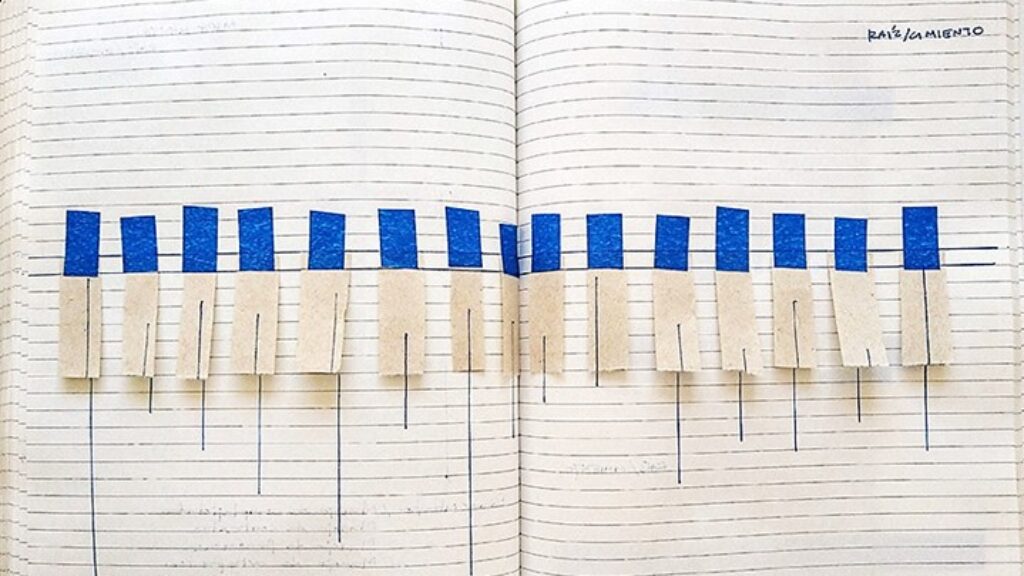
A BUNCH OF COMPLEXITIES
Since I started the Horizons* project I have kept an edited record in a notebook. I say edited because in this notebook I have organized notes, ideas, diagrams and images that I collect during work periods. The editing forces and allows me to organize what I understand as a process that otherwise would be lost since I have acquired the habit of not saving, not annotating, not preserving most of the aspects that make up the development of the project. Perhaps because I think that my processes are nothing extraordinary; there is a lot of reading/writing that awaits and/or complements an image, a problem to be solved, a discovery or a situation experienced or to be experienced. I don’t know how to manifest those periods of reflection where it seems like nothing happens and they constitute a kind of gap or remain for some time like a blank page. I think of my processes, fundamentally, as technical work: measuring, cutting, making mistakes, getting it right, assembling, installing, acting. I am not an artist who plans too much, one who sketches his ideas over and over again; perhaps because I value improvisation and experimentation over a carefully planned situation.
Lately, in addition, I have been dealing with this current condition of being an artist where everything is subject to creative speculation and everything must be recorded and, above all, published. When I say current condition, I am referring to this subordination to social media and network to express our creative work. It seems to me that there is an excess of images circulating on the internet, we consume them without thinking too much about the benefit we can obtain from these and, on the contrary, they force us to stay connected waiting for more content. In that sense, it seems to me that it would be good to learn to discriminate what is in fact part of the process and to rethink and problematize the process itself. So, this collaboration with Witte Rook is a favorable occasion to reflect on my own questions. Personally, I find it hard to adapt to this new normal where digital presence plays a relevant role. I think about the pros and cons of this new way of interaction and its implications and I do not position myself for or against. In any case, it seems to me that given this situation, virtual instead of in person, some other ways can be found to reconcile one with the other to create satisfactory solutions.
At the end of the day, it is a personal decision to share or not share what is part of the finished work that to me appears as an artistic proposal. There are those who believe that the shared experience of the process enriches this proposal; there are those who believe that the experience and the proposal are part of the same thing; there are those who value one thing more highly than the other; there are those who create more or less reliable methods; there are those for whom everything is an experiment; there are even those who do not think too much about process and trust in its effectiveness and creative lucidity. It seems to me that everything described here is a process, that the creative task is a bunch of complexities an and exercise of introspection and that each person understands in their own way what a process means.
In this publication you will find a selection of texts and images that are part of the Horizons project, specifically the three Root / Foundation pieces made so far, some finished, some in process, some simply imagined. I have proposed that the way to socialize my work in processual terms is, especially, physically during my next stay in Breda so this publication is intended to serve as a small introduction of what I find important about my work.
DECEPTION OR KNOWLEGDE?
Thomas Mann says that an artist is someone who has to live with a guilty conscience. One presumes, he says, that a writer with his great works will reveal a mystery to us, leading us to a certain truth, but deep down the writer knows that he has no absolute answer to any truth at all. [1] On the contrary, Alejandro Dolina comments in an interview [2] that the ultimate goal of art is the pursuit of truth. Although art itself is not true, he tells us that the light, the very last light that sheds on things leads us to the truth. Art, he continues, is manipulation rather than deception and the artist is someone who uses resources, forms that manipulate our conception of reality. Art presents us what is not as if it were and in this way appeals to both emotion and intellect. Dolina also adds that every good artist leads us to reflect on the human condition, a tragic condition by nature. What does this mean? What does it means for art to know the truth? If art does clarify things, Why it is so hard to explain that clarity? Maybe because we only see the first light, the one that is on the surface and we miss the shadows, what is not clear but leads us to see.
We may not know what it is, we may not know what it is for, but we seem to be convinced that art has value. What is that value? In his text Art and Knowledge (2004) Juan Luis Moraza wonders about a possible epistemology of art: What is art? Art is what? And it begins with a precise clarification of what is known when someone knows about art, describing it as a complex experience that is at the peak of what we know as sapiens in an integral sense of the word |…| Art has developed as an experience capable of integrating cognitive simulation systems (perceptual, conceptual and emotional) into units of knowledge |…| [3].
Moraza continues wondering about the fundamental purpose of art in terms of knowledge: |…| The fundamental purpose of art belongs to the integral nature of the human mind, to the fact that a person acquires knowledge and guides its actions not through isolated perceptions but through systems of abstraction and correspondence, systems of translation and integration. Just as articulate language serves to convert conceptual abstractions into something understandable, sensory and emotional complexities into their concrete equivalents and thus make a large amount of knowledge; art satisfies the cognitive need for condensation and economy for the values of perceptual, affective and conceptual judgment. No other human activity has integrated these different, although complementary, cognitive areas in such a non-exclusive way. [4] This way of knowing then supposes sensory/intellectual dissolution. Sapiens includes both the sensorial motor of the sophisticated palate, and the categorical intellect of understanding and wisdom; |…| Given that sapiens identifies knowledge with flavor, [5] it will be appropriate to also identify homo sapiens as the hominid that tastes. Sapiens is not only the one who thinks by knowing or the one who knows by thinking, but also and above all the one who knows from the palate |…| He not only sees but sees himself seeing, not only knows but knows about his knowledge. He tastes, he observes, he spices up, he stops being subject to the relationships of behavioral continuity, of immediacy between stimulus and response, he senses an interval, a distance, a delay. Species only exist from the saboer. [6] |…| The work of art, rather than an object of knowledge, is an object of saboer. Object of saboer because it presents itself to us as an object that promotes not only the knowledge but also a kind of relish that implies certain denail of the sensory-intellectual dichotomy.
Moraza equates the complexity of human thought |homo sapiens| with the complexity of the artistic experience given that when “experimenting with art” the same understanding capacities that are required in thought are brought into play to transform sensory intellectual and emotive abstractions into units of know, into knowledge. |saber y conocimiento| Art, he tells us, can create a language far from any semantic specificity or subject, on the contrary, to the purely emotional sense.
The theory proposed by Moraza of art as saboer takes up this wordplay |saber y sabor| in spanish where knowledge and flavor lead to a cognitive experience. When Moraza tells us that the homo sapiens identifies knowledge with flavor, he refers to the meaning of both words in Spanish, given that to express knowledge and flavor |saber y sabor| we use the word saber interchangeably. The inflection of Moraza’s theory between flavor and knowledge occurs precisely when comparing knowledge with flavor, to the fact that we get to know not only with thought but also, and above all, from the palate. We know things by their taste; so to know is to taste, to try, to understand, to judge from taste. Savoring is a preamble to a definitive immersion where the external appearance of things becomes internal, where perception becomes taste and taste becomes saboer, that is, in the representation that our brain makes of the things we know and that we savor.
Thus, when Moraza suggests art as an object of flavor |saber| rather than an object of knowledge, |conocimiento| I can refer here to the differentiation between knowledge and wisdom just to try an attempt to establish a possible differentiation between both meanings in the English language. An artistic object is not interrogated or confronted to turn a subject into a learned person, rather, its presence offers us an saber y un sabor that call us to a face-to-face experience |a savoring,a relish| where the complexity of abstraction is “judged” by the taste, that is, before being understood as a work of art it offers us a flavor and a knowledge where the emotional, the sensory and the intellectual appear together.
If the hypothesis of art as saboer is supported, what would it be to know about art? Or to know art? Does it ask for a connoisseur? In any case, the peculiar imperfection of art would make us think that knowing about art would require not accepting any hypothesis of artistic knowledge as good, so the first condition for knowing about art would consist of not knowing, in the awareness of the unsustainability of knowledge, and much more, from the knowledge that is known. [7]
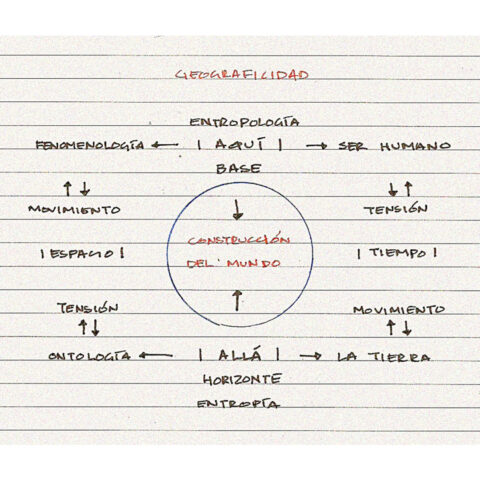
GEOGRAFICITHÉ Sketches. Notebook- MAPA MENTAL.
Root / Foundation
Root / Foundation is a serie of three sculptural sites that respond to the concept of beginning, foundation, starting point. It constitutes a basic construction exercise around the idea of building and at the same time aims to express a more complex notion around the idea of inhabiting. By basic construction I mean my sculptural work, and in this very specific case, I’m refering to the system I’m using to build sculptures which is called through joints and lapped joints using wood and reed as main materials. When I say a more complex idea of inhabiting I’m referring to the whole Horizons project responding to my own questions about how and where I experience my “terrestrial condition” that “ties” me to the earth | paraphrasing Eric Dardel | [8] and the way in which I manifest my relationship with the space in which I am/live.
This specific serie arises in a moment of “strangeness” in my life in which it is also related to an idea of end, complement, point of arrival; from where my body, a physical bodily experience, is the irrefutable evidence of my relationship with space as a constructive experience wich is the life itself. My body is my root and my foundation, it is my base to discover the world; in that sense, if inhabiting is being itself through the body, ceasing to be for me is inhabiting the strangeness without a body. I briefly turn here to what Leon Tolstoi proposed to exemplify the undeniable relationship of the body as a construction with the earth. How much land does a man need? [9] The answer, 2m: from head to toes, enough to fit there and be buried. The strangeness of being as a physical construction in the space is well described by Carlos Thiebaut when he says:
“|…|the strangeness comes more from memory, from what was here and is not longer there, from what was happening and is not longer happening|…|strangeness in the face of one’s own is marked by time and memory is its cartography |…| Appropiating a city is weaving in it, in memory, our own place.” [10]
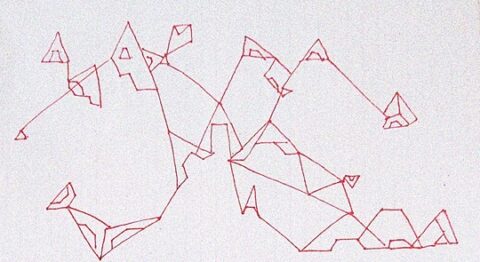
ROOT / FOUNDATION. Sketches. Notebook CRECER – EXPANDIR – SOSTENER – OCULTAR.
|…| I had in my head this idea of a root as a body, like a latency that reproduces underground. What does the idea of “taking roots” mean? How can I take root if my desire is movement?
A woman was talking about plants, wonderful, she said, they have to deal with all their surrounding problems because they can’t “leave” their place. They have to develop defense mechanisms to survive and protect themselves from whatever the threat is. We can leave, she continued, if our place threatens us we can flee. We change places. Plants grow. Us? |…|
|…| perhaps the path of uncertainty needs a recount. When my head is empty, full of doubts, I turn to what has already been done. Could it be this going backwards, this nostalgia as Emile Ciorán calls it, a denial of the present [11] because we do not know what to do with it. Flee. Then I remember that in reality we just do nothing but dwell on the same things throughout our life; that there is no such thing as novelty. I don’t know what to do with this bunch of complexities. There’s not much to do. We are subject, like plants, to doing the same things, in order to stay in the same place despite being in motion |…|
|…| I’m still thinking on similar questions because I’m still listening to similar thoughts: you have to “dry” the trees. They look very nice infront your house but they are gonna take roots and the root will damage the wall, the foundation of your house. Do I have to kill them to preserve the wall?
|…| then Camila died after a year sick. So, we wonder what we should do with her body. Where should we bury her? Now she rests in the garden, after twelve years with us.
|…| relentless death haunting my mind.
|…| the constant pain.
|…| what death really is?
|…| what the roots look like? Are they the stangeness?
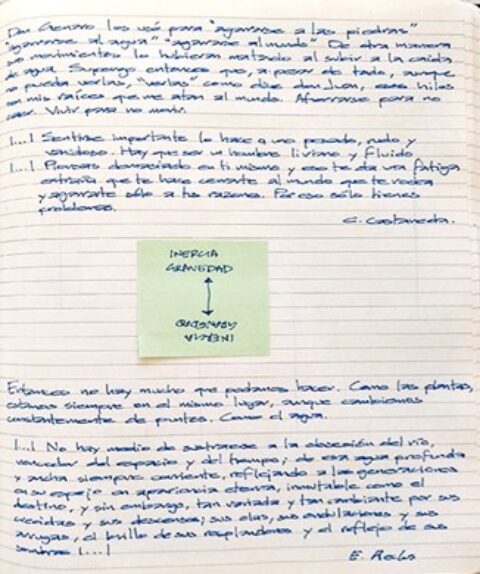
ROOT / FOUNDATION. Sketches. Notebook ÁRBOL – RAÍZ – TRONCO – RAMAS.
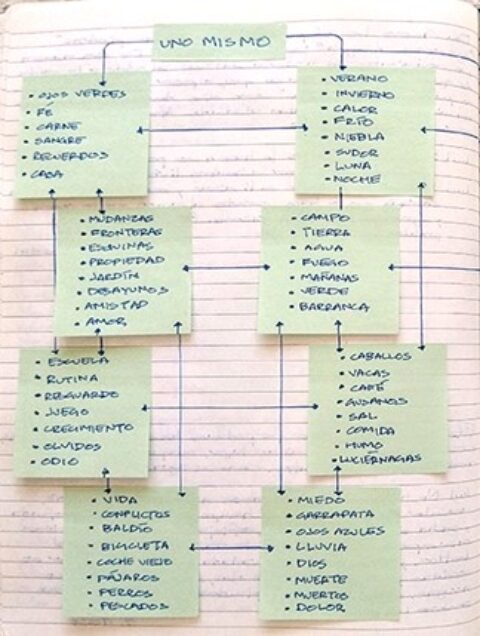
ROOT / FOUNDATION. Sketches. Notebook ÁRBOL – RAÍZ – TRONCO – RAMAS.
CITIZEN OR PILGRIM? WHAT WE DO IN SPACE? | HOW WE DO IN SPACE?
If we accept the fact that the landscape is not a sublimated image of nature, but is essentially an experience in tension between the individual and his environment, it would be possible to accept that what arises in the space inhabited by human beings, in addition to the landscape, is a situation with respect to which we decide to act in one way or another. What we do in space is how we do in space.
Francesco Careri says in his book |Walkscapes, 2002| [12] that our decisions could have been determined from the very beginning, as citizens or as pilgrims, as told by the hebrew people in Genesis, making an “architectural” extrapolation of the spatial and temporal history of Cain and Abel. To the first corresponds the power of the entire earth and to the second that of all living beings. Cain busily tilled the land while Abel idly herded the cattle; while one established a “productive” relationship with the earth, the other established a “playful” one, both considerations giving rise to what we can initially call anthroposphere, anthropic space, that is, the place to which human habitation corresponds. Both circumstances, the playful and the productive one, could have established a starting point for the assimilation of our own place and task after full awareness of the individual relationship with the environment and with nature in a qualitative way.
It could be thought that anthropic space extended its borders towards what would later be understood as landscape and in turn this extended its borders towards what we could call architecture. Logic would dictate that it would have been Cain and his productive work with the land that gave rise to the first cities and yet, Careri continues, it is more likely that architecture was built |in the first place| by Abel’s walking, wandering, idle grazing, movement being the first architectural intervention, the first anthropic sign in the landscape.
It is worth asking here what were the signs built by Cain when he tilled the land? And if these signs lacked a symbolic meaning that could establish a relationship between productive work and idle contemplation? But as is known, there was no time for such elucidations since Cain killed Abel after God was more pleased with the offering of his brother and he was thus condemned to farm the land without receiving its fruit, a wanderer and a foreigner in his own land. In this way, the sentence dictates that Cain’s descendants were nomadic and that they were promised a land to make it their own; that is the city, |secondly|, not only came from that erratic condition of the first men but it has always been the desire for roots and property that has given meaning and place.
I’m coming back to these ideas not only because they are related to my work, but also because this idea of being in motion has traversed my life and thoughts since a long time now. Personally, I have been in a dilemma, that is continuing to reproduce our consumption habits |because I suppose that space is also consumed| or to choose a basic form of production |with the understanding that space must be produced|. Even though I consider that my spirit is much closer to the mountain than to the cathedral, it has been very difficult for me to leave the city permanently; that is why I have undertaken this work that I cannot separate from my own personal experience. My work as a sculptor is an attempt to find my base, to define my place in the world.

ROOT / FOUNDATION. Triptych. Drawing. Ink on Wood.
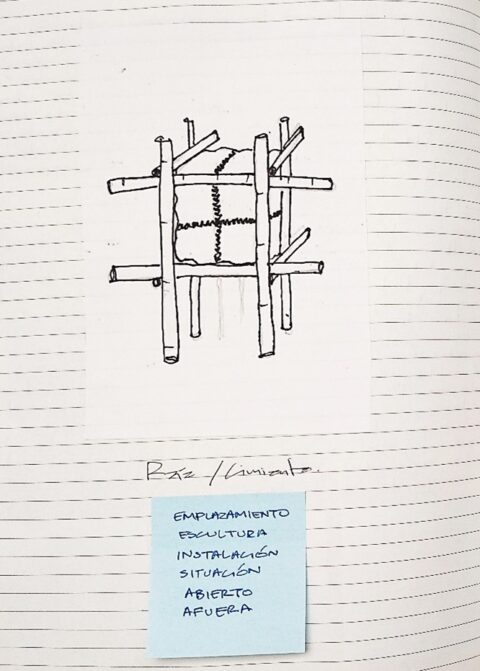
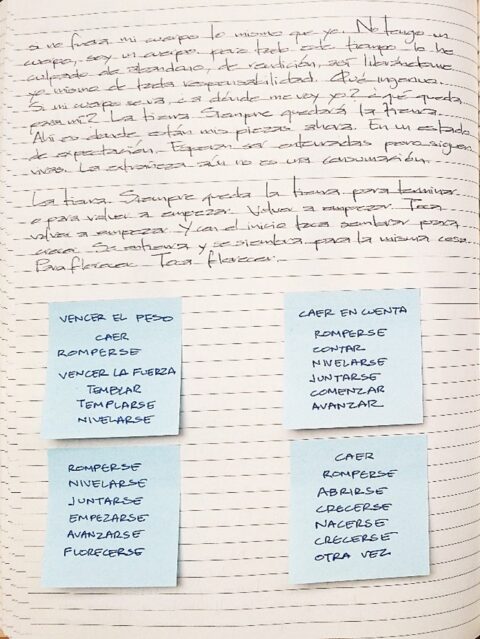
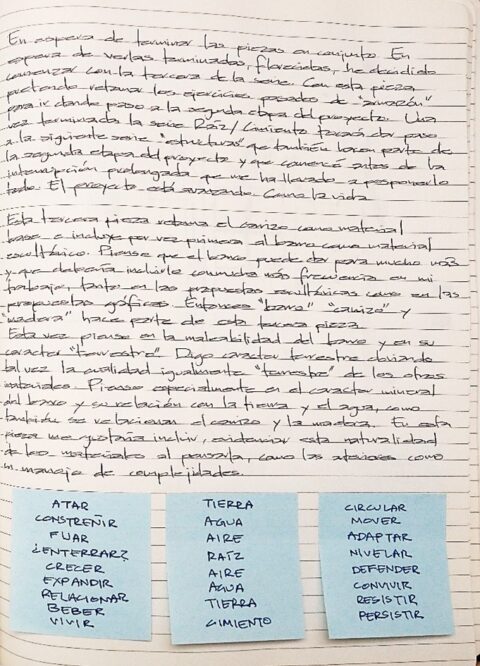
ROOT / FOUNDATION. Sketches. Notebook. MAPA MENTAL. RAÍZ / CIMIENTO.
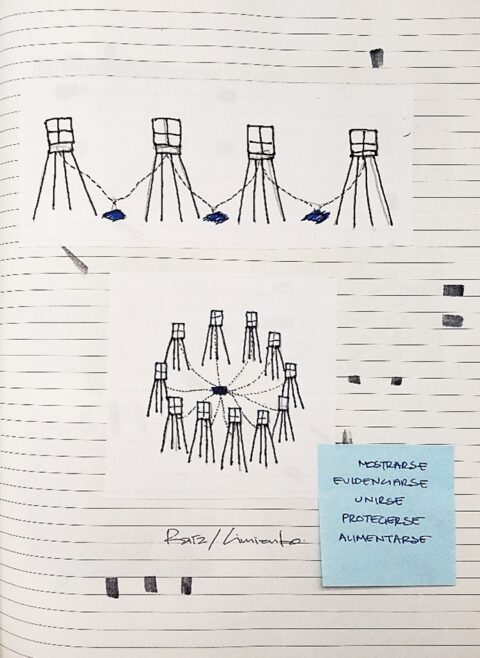
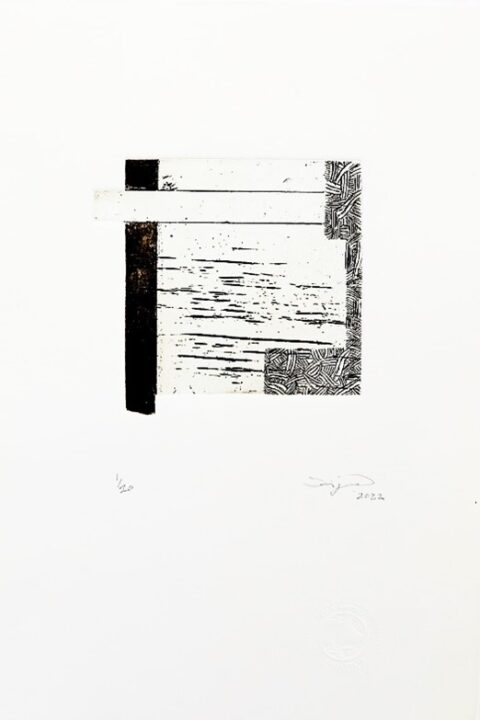
ROOT / FOUNDATION. Etching.
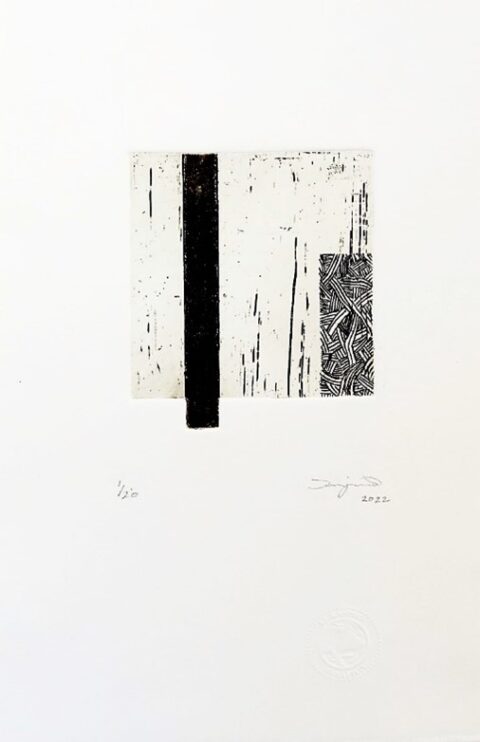
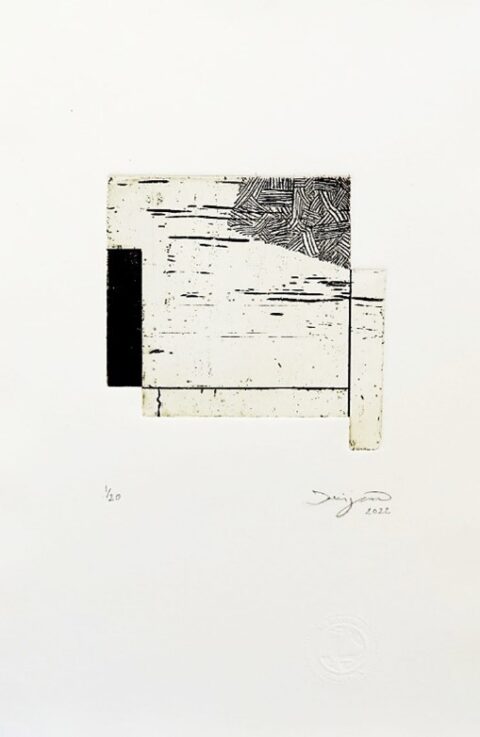
ROOT / FOUNDATION. Etching.
Look by walking
Explore the view with your feet
Sometimes I’d like to figure out what I’m really looking for
A loss of consciousness
Not being sure of anything
Build from insecurity, from what is probable, from what is not certain
Where do we go to not leave a trace?
Do we leave a trace?
Will there be someone who will remember us forever?
How long is forever?
The wind will erase us
The wind that lifts the earth
The dust we were
The dust we will become.
TO WEIGHT THE FORCE / PESAR LA FUERZA
The earth hardens with so much heat
it turns into stone
The stones under the sun
The sun under the stones
Weigh the force
Build under uncertainty
Build on the insecure
I’d like to know what I’m missing
Gain strength
Weight the force
Step on the earth, under my feet
Save the earth, under my eyes
The earth you will become.
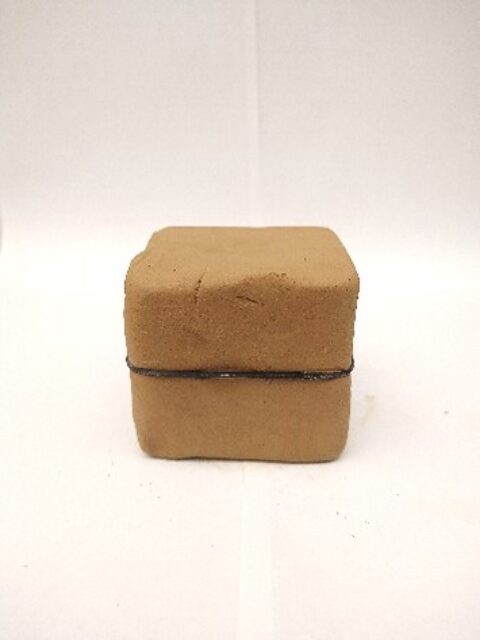
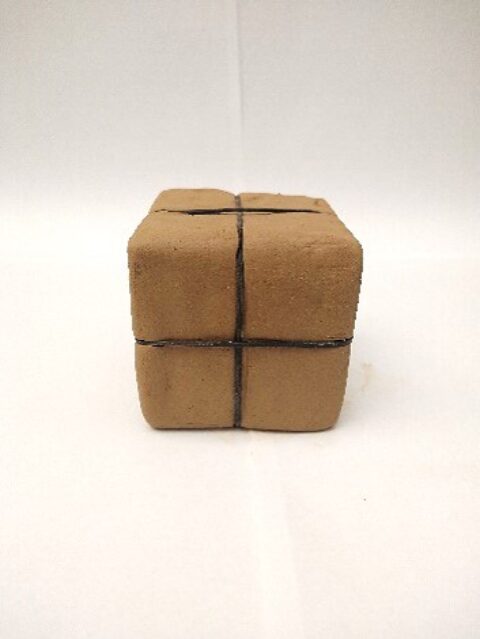
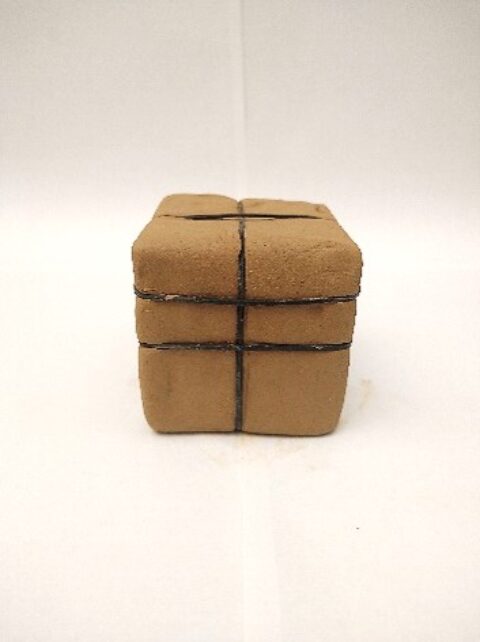
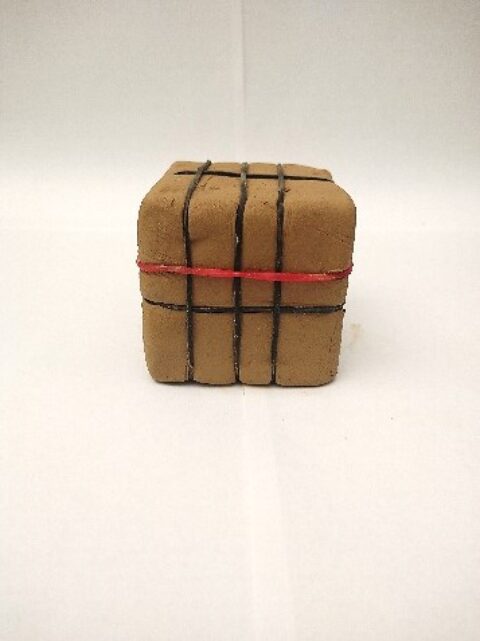
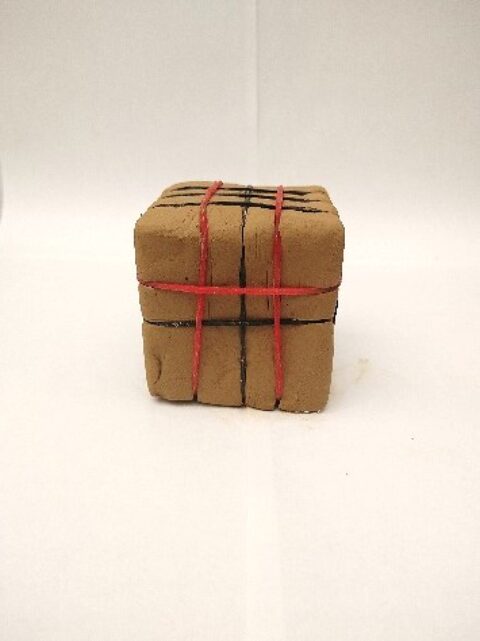
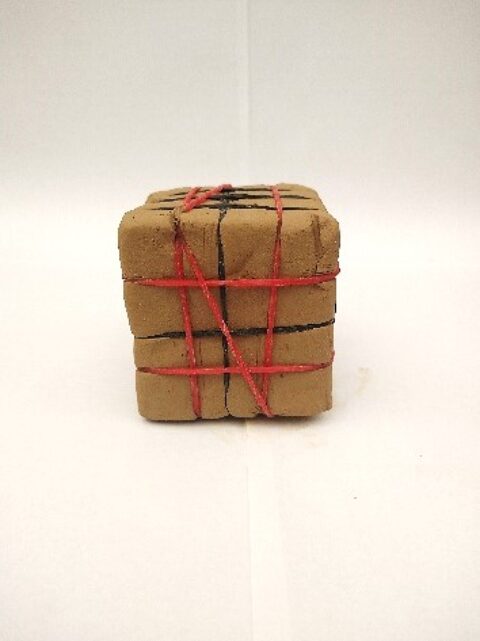
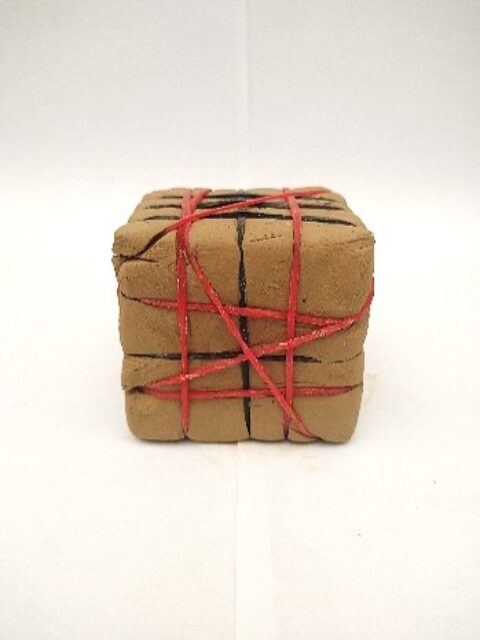
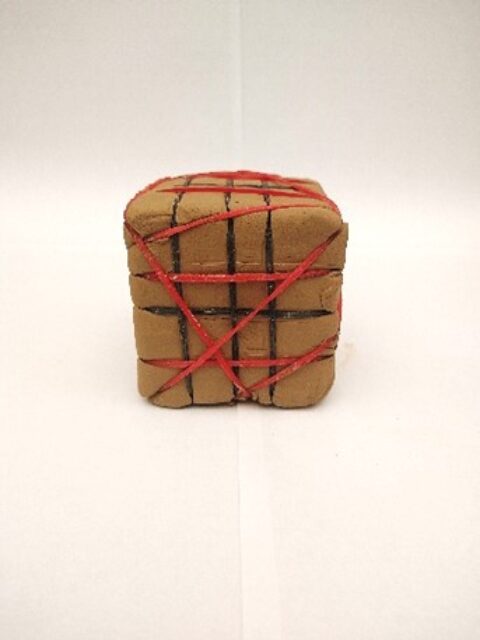
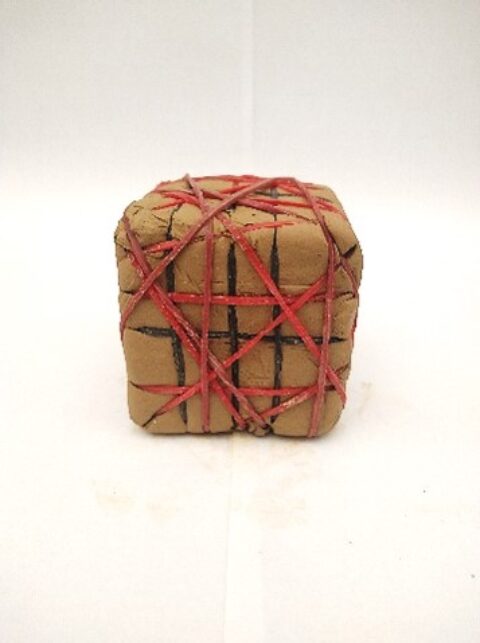
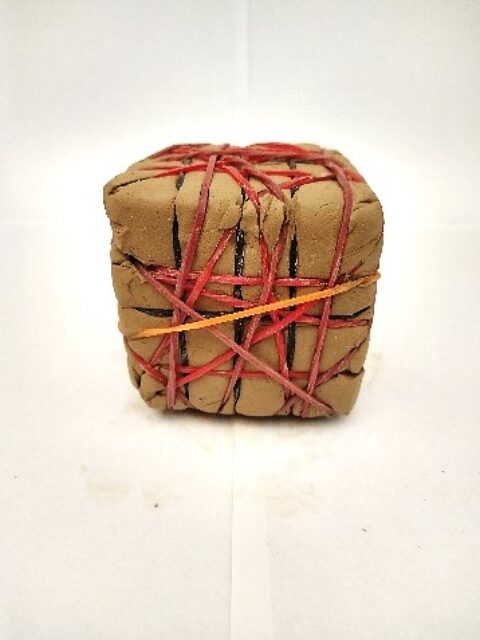
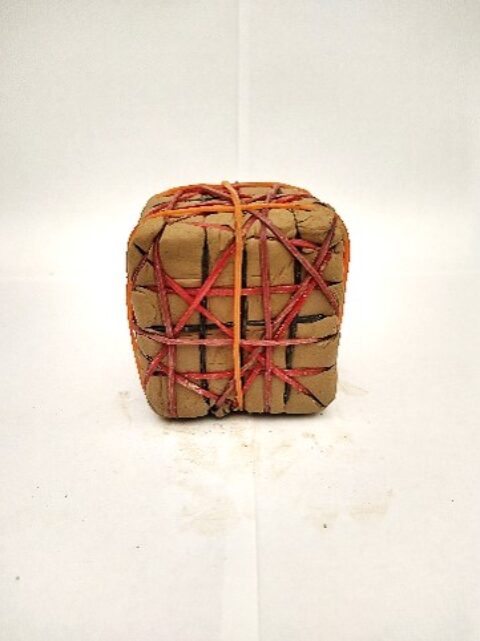
ROOT / FOUNDATION. A bunch of complexities. Clay and rubber band. Models and sketches.
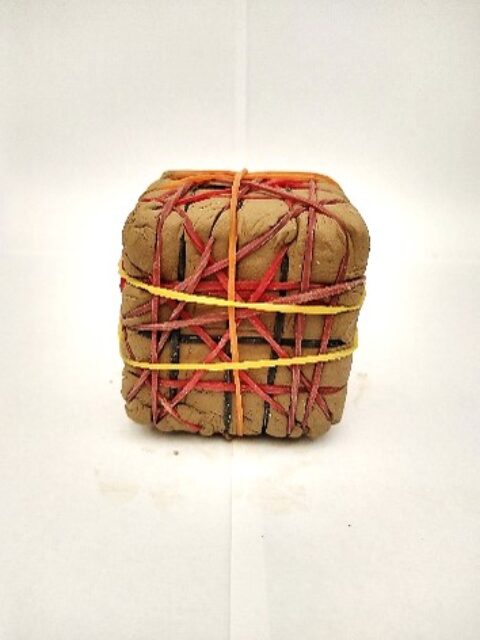
[1]. Mann, Thomas. Story of my life. Salvat Editorial. Navarra 1972. Page 77.
[2]. Filo news. 29/09/2022. “Science seems to have more magic than art”| Caja Negra. Alejandro Dolina. Interview |youtubevideo| https://youtu.be/SKjh7Fa-8j4?si=YiYtxldFZX4bQSB
[3]. Moraza, Juan Luis. Art and Knowledge. Arteleku. San Sebastián. UNIA. Sevilla 2004. The whole theory of art as knowledge |art as saboer| belongs to Moraza ideas.
[4]. Moraza, Juan Luis. Op Cit. Page. 1
[5]. This is a playword. Saber y sabor. Saberes y sabores. We say in spanish saber and saber meaning to taste and to know. It is the same word for to taste like and to know about.
[6]. Moraza, Juan Luis. Op Cit. Page. 1
[7]. Moraza, Juan Luis. Op Cit. Page. 20
[8]. Dardel, Eric. The man and the earth. Nature of geographical reality. Landscape and theory. New Library. Paris 1952.
[9]. Tolstói, León. How much land does a man need? The russian wealth #4. Magazine. St. Petersburg. 1886.
[10]. Thiebaut, Carlos. The missed identity. Maps, times and figures. Aesthetic newsletter. Buenos Aires 2004. Page 14.
[11]. Ciorán Emil. Rot breviary. Taurus Editorial. España 1972.
[12]. Careri, Francesco. Walkscapes. Walking as an artistic practice. Gustavo Gili Editorial. Barcelona 2002.

